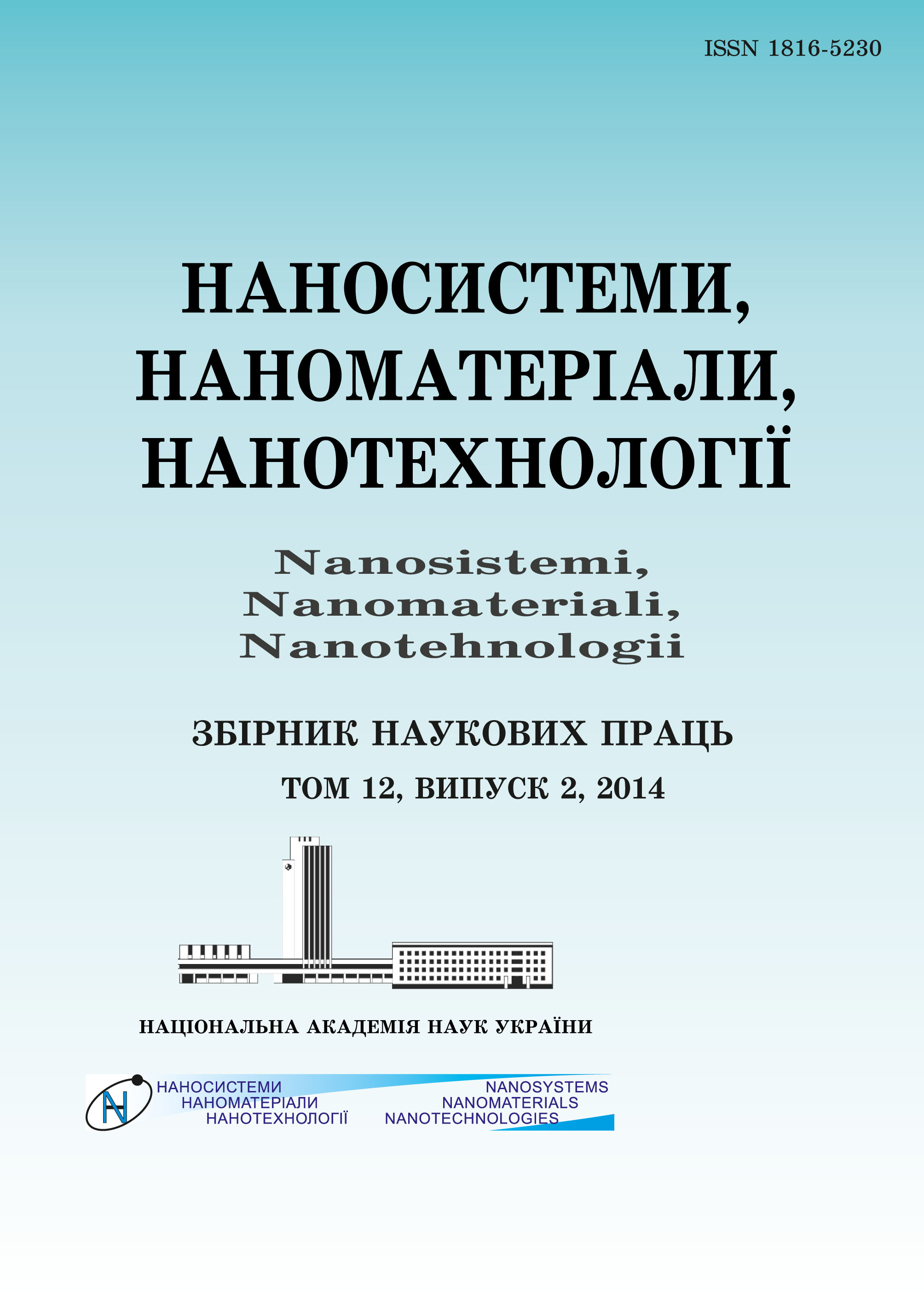|
|
|||||||||

|
Year 2025 Volume 23, Issue 2 |
|
|||||||
|
|||||||||
Issues/2025/vol. 23 /issue 2 |
|
M. A. ZABOLOTNYY1, L. I. ASLAMOVA1, G. I. DOVBESHKO2, O. P. GNATYUK2, V. Yu. POVARCHUK2, D. S. LEONOV3, R. V. LYTVYN3,7, and M. Yu. BARABASH3–6
1Taras Shevchenko National University of Kyiv, 64, Volodymyrs'ka Str., UA-01033 Kyiv, Ukraine
2Institute of Physics, N.A.S. of Ukraine, 46, Nauky Ave., UA-03028 Kyiv, Ukraine
3Technical Centre, N.A.S. of Ukraine, 13, Pokrovs'ka Str., UA-04070 Kyiv, Ukraine
4Gas Institute, N.A.S. of Ukraine, 39, Degtyarivs'ka Str., UA-03113 Kyiv, Ukraine
5National Technical University of Ukraine 'Igor Sikorsky Kyiv Polytechnic Institute', 37, Beresteiskyi Ave., UA-03056 Kyiv, Ukraine
6Institute for Applied Control Systems, N.A.S. of Ukraine, 42, Academician Glushkov Ave., UA-03187 Kyiv, Ukraine
7I. M. Frantsevych Institute for Problems of Materials Sciences, N.A.S. of Ukraine, 3, Omeljan Pritsak Str., UA-03142 Kyiv, Ukraine
Modification of Optical Spectra and Cytostasis of Doxorubicin and Conium Solutions with High-Energy Electron Irradiation
489–500 (2025)
PACS numbers: 33.20.-t, 78.20.Ci, 78.40.Me, 78.67.Bf, 87.19.xj, 87.53.Bn, 87.64.km
The characteristics of optical absorption and cytostatic activity under high-energy electron irradiation of a solution of doxorubicin (of anthracycline class) in sodium chloride are studied. The energy of irradiating electrons was of 1 MeV, and the absorbed dose was within 2–90 kGy. As proven, when sodium chloride is irradiated, the absorbed dose affects the optical absorption spectra of samples and leads to an increase in the cytostatic effect of the drug. As shown, the optical spectra and cytostatic activity change with time in a co-ordinated manner. The dissolution of conium (of alkaloid class) in irradiated sodium chloride causes shifts of the maxima of the infrared absorption spectra of conium. A possible reason for the changes in solution properties, when using pre-irradiated sodium chloride, is the conformational rearrangement of the antitumour drug molecules. This effect can be caused by the interaction with bubbstons and their clusters, which are formed under the impact of irradiation.
KEY WORDS: NaCl, doxorubicin, conium, bubbstons, optical absorption, high-energy electrons, radiation dose, cytotoxicity
DOI: https://doi.org/10.15407/nnn.23.02.0489
REFERENCES
- L. Aslamova, M. Zabolotnyy, G. Dovbeshko, G. Solyanik, O. Gnatyuk, and M. Tsapko, Proceedings of International Conference 'Medical Physics 2023' (9–11 November 2023, Kaunas, Lithuania), p. 149–152.
- Dharmendra Kumar, Journal of Nanomedicine Research, 7, Iss, 4: 262 (2018); doi:10.15406/jnmr.2018.07.00197
- M. A. Zabolotnyy, M. P. Kulish, O. P. Dmytrenko, G. I. Solyanyk, Yu. I. Prylutskyi, M. A. Drapikovskyi, M. O. Kuzmenko, N. A. Poluyan, and V. A. Kiyashko, Method of Modification of Water-Soluble Anticancer Drugs Using Radiation Exposure (Patent for the Invention of Ukraine No. 116, 227; Registered on 26.02.2018).
- Rashmi Bangarh, Reena V. Saini, Adesh K. Saini, Tejveer Singh, Hemant Joshi, Seema Ramniwas, Moyad Shahwan, and Hardeep Singh Tuli, Cancer Pathogenesis and Therapy, 3, Iss. 2: 120 (2025); https://doi.org/10.1016/j.cpt.2024.07.002
- L. Aslamova, M. Zabolotnyy, G. Dovbeshko, and G. Solyanik, Proceedings of 15th International Conference 'Medical Physics in the Baltic States 2021' (4–6 November 2021, Kaunas, Lithuania), p. 70–73.
- M. A. Zabolotnyy, N. A. Poluyan, G. I. Dovbeshko, Yu. M. Kondratzky, M. P. Kulish, A. I. Momot, and O. P. Dmytrenko, Nanosistemi, Nanomateriali, Nanotehnologii, 12, Iss, 4: 651 (2014) (in Ukrainian); https://www.imp.kiev.ua/nanosys/media/pdf/2014/4/nano_vol12_iss4_p0651p0664_2014.pdf
- Dominik Kosior, Agata Wiertel-Pochopien, Przemyslaw B. Kowalczuk, and Jan Zawala, Minerals, 13, Iss. 9: 1130 (2023); https://doi.org/10.3390/min13091130
- M. A. Zabolotnyy, L. I. Aslsmova, G. I. Dovbeshko, O. P. Gnatyuk, G. I. Solyanyk, V. P. Dankevych, D. S. Leonov, M. Yu. Barabash, and V. A. Chernyak, Nanosistemi, Nanomateriali, Nanotehnologii, 22, Iss. 2: 481 (2024) (in Ukrainian); https://doi.org/10.15407/nnn.22.02.481
- C. G. Gray and P. J. Stiles, European Journal of Physics, 39, No. 5: 053002 (2018); doi:10.1088/1361-6404/aaca5a
- M. A. Zabolotnyy, L. I. Aslamova, G. I. Dovbeshko, O. P. Gnatyuk, V. B. Neimash, V.Yu. Povarchuk, V. E. Orel, D. L. Kolesnyk, L. M. Kirkilevska, and G. I. Solyanyk, Nuclear Physics and Atomic Energy, 23: 131 (2022); https://doi.org/10.15407/jnpae2022.02.131
- A. I. Momot, A. G. Zagorodny, and I. S. Orel, Phys. Rev. E, 95, No. 1: 013212 (2017); https://doi.org/10.1103/PhysRevE.95.013212
 This article is licensed under the Creative Commons Attribution-NoDerivatives 4.0 International License ©2003 NANOSISTEMI, NANOMATERIALI, NANOTEHNOLOGII G. V. Kurdyumov Institute for Metal Physics of the National Academy of Sciences of Ukraine. E-mail: tatar@imp.kiev.ua Phones and address of the editorial office About the collection User agreement |